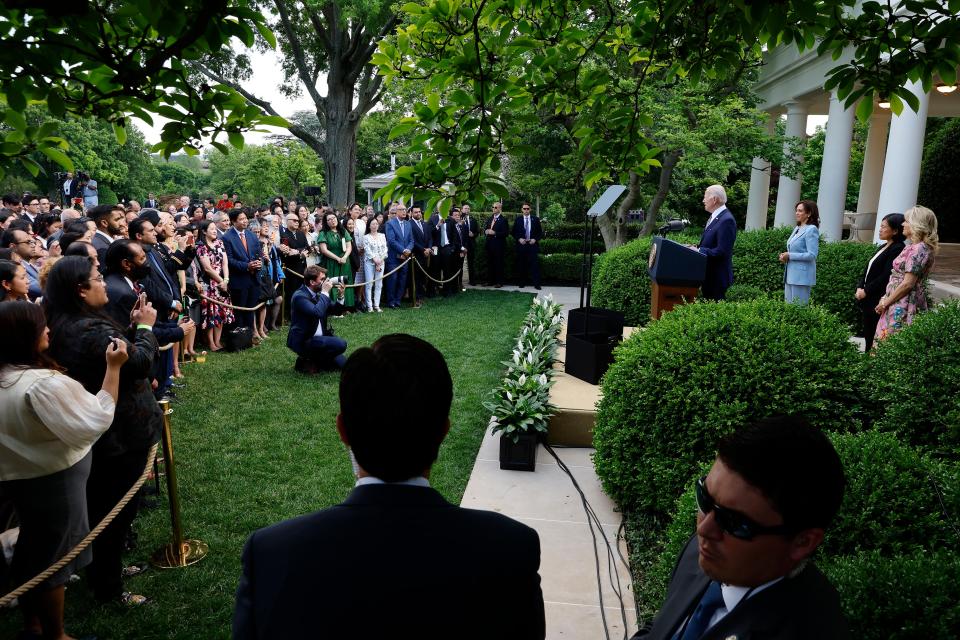COVID tests for US travelers from China spark fears of new wave of anti-Asian hate
- Oops!Something went wrong.Please try again later.
New COVID-19 testing mandates for travelers arriving from China into the U.S. went into effect Thursday, requiring all passengers two and older to provide negative results from tests taken no more than two days before travel.
While other nations such as Japan, India and South Korea have taken similar measures, some Asian community advocates in the U.S. worry that the move could spark anti-Asian hate and bias while unfairly singling out one particular group of travelers.
Harmful rhetoric may ignite the firestorm, advocates say.
“What we’ve seen is that it’s not only policies alone that spur incidents, but the language that elected officials and public figures use,” said Manjusha Kulkarni, co-founder of Stop AAPI Hate, a San Francisco-based consortium of several groups formed in response to rising anti-Asian sentiment during the COVID-19 pandemic.

Kulkarni cited inflammatory terms such as “kung flu” used by former President Donald Trump and others as the pandemic began to unfold in 2020, followed by the stricter public charge rules affecting Asian immigrants and mass deportations of those from Southeast Asia.
“Since we started receiving incident reports in March 2020, we have more than 11,000 reports from individuals across the country who have experienced anti-Asian hate,” said Kulkarni, who is also executive director of the AAPI Equity Alliance, a coalition of organizations serving Asian Americans and Pacific Islanders in Los Angeles County, California. “There are many sources of information that drive animosity, but combined, it has the effect of legitimizing the scapegoating of Chinese Americans and other Asian Americans.”
Here’s what to know.
Why did the U.S. make the change?
The U.S. had lifted the last of its negative-test mandates for travelers in June, although the CDC still suggested that passengers be tested just prior to flights and that they avoid travel if they were sick.
COVID-19 testing requirements have been recently instituted or renewed by the U.S. and other countries as infection rates surge in China following a relaxing of that nation’s rigid anti-virus restrictions. China had initially adopted a “zero COVID” strategy that kept infection rates low but hampered the nation’s economy while fueling public resentment.
In addition to the CDC’s renewed restrictions, at least one cruise line operator – Norwegian Cruise Line Holdings, which runs the Norwegian, Oceania and Regent Seven Seas lines – is now requiring pre-cruise testing for passengers whose travels have taken them to mainland China, Hong Kong or Macau in the previous 10 days.
The moves come as China anticipates its busiest travel season – Lunar New Year, which starts Jan. 22.
Why are advocates concerned?
Community advocates worry that, as in the earlier stages of the pandemic, targeting travelers from a specific region may inadvertently give rise to blanket bias and mistreatment of Asian Americans.

Frank Wu, president of Queens College, City University of New York, noted that the pandemic’s accompanying rise in anti-Asian sentiment not only targeted Asian Americans but even others thought to be. In April 2021, for instance, a 70-year-old Mexican American woman was reportedly brutalized aboard a metro bus in Los Angeles by an attacker who mistook her as Asian.
“Many of the people attacked were not of Chinese descent,” Wu said. “But they were blamed for the virus. What the hate crimes showed is that haters do not draw distinctions.”
Such sentiments were further provoked by the words and actions of political leaders and public figures, Kulkarni said.
“Our major concern is when discrimination and racism overrule science,” she said. “We saw some of that at the start of COVID: Instead of taking responsibility for the outbreak in the U.S., the Trump administration looked to pin the blame on China specifically. Prejudice against Asian Americans became a distraction to finding solutions to the pandemic when they were critically needed.”
What measures could be taken instead?
Kulkarni said that while it’s important to follow public health experts’ advice, it’s unfair to single to single out a particular geographic region – even as experts predict up to 2 million deaths and hundreds of millions of infections in China as a result of its eased restrictions.

“We know infection rates are on the rise in many countries across the globe,” Kulkarni said. “If we are truly worried about these variants and their spread through travel, then we should consider looking at new masking policies and requiring negative tests for all travelers, no matter where they come from.”
Wu said that while it makes sense to set up protocols to protect the U.S. from particular areas with severe COVID-19 outbreaks, such actions should be cautiously implemented.
“We just need to be careful,” Wu said. “Good policies can inspire bad actions.”
Dig Deeper
This article originally appeared on USA TODAY: COVID-19: Test mandates for travelers from China renew fears of bias

